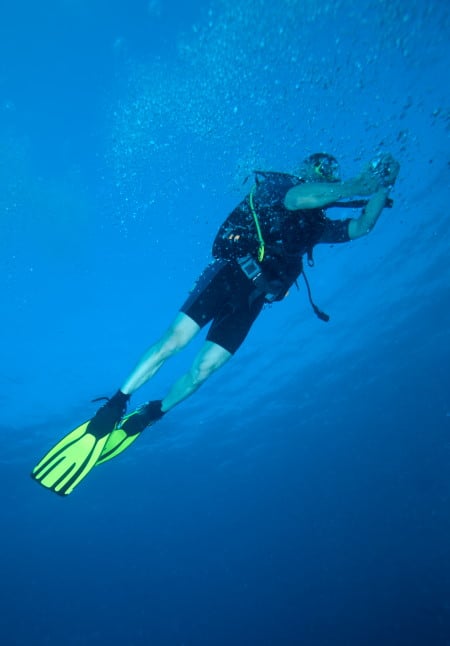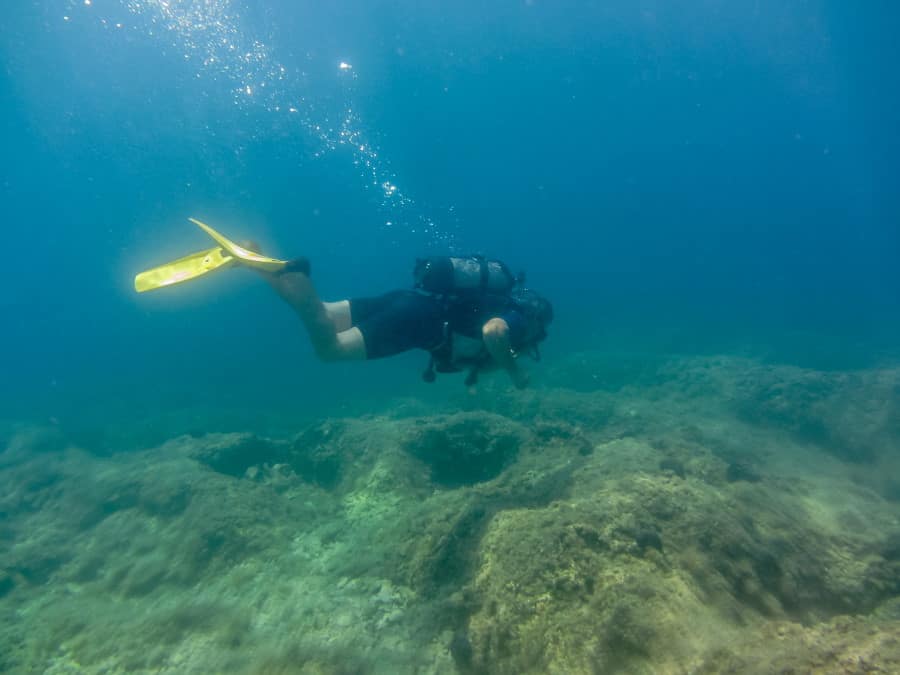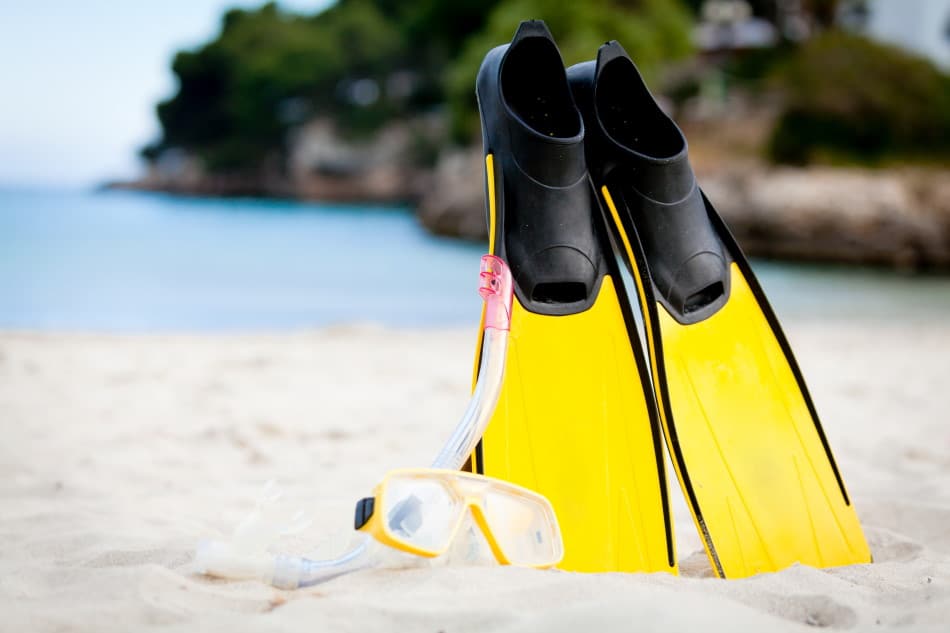Yum Yum Yellow – What Colors attract Sharks when Diving?
Before we start talking about how sharks are attracted to certain colors and repelled by others, it is important to note that these are just theories by divers, rescuers, and surfers. A study was conducted by the US Navy in the 1970s to see what color life jackets they should use so sharks would be least attracted to them.
What they found was that sharks were most attracted to yellow, and were more likely to attack that color than any other. However, scientists argued that for color vision, sharks are required to have both rods and cones present in their eyes like humans. Cones are what make humans see color, and in most sharks, only one type of cone was seen; proving that they can only see shades rather than color. Every silhouette in the water will still just look like a silhouette.
Though these experiments prove that sharks are most likely colorblind, strong believers still exist on both sides of the argument. People who believe the color does have an effect on sharks are often those who are part of the water frequenting community.
What is Yum Yum Yellow?
Yum Yum Yellow is the name given to the bright color yellow that is often seen on life jackets, scuba diving accessories or surfboards. A surfer named Mick Fanning was recently attacked by a Great White Shark in the middle of a surfing competition on live television; he was on a yellow surfboard. This re-sparked the conversation around the fact that sharks are attracted to the bright color normally associated with happiness.
Why is it Called Yum Yum Yellow?
The name “Yum Yum Yellow” is literally given to the name because sharks apparently find it yummy. Rescue workers and other water frequenters like scuba divers started referring to the shade of yellow as what it is known as now because of its tendency to attract sharks; especially to lone or stranded swimmers.
Are Sharks Attracted to the Color Yellow? – What Colours attract Sharks?
There has been scientific research done on the vision and color-seeing ability of sharks to prove that they are indeed colorblind. Scientists tested the eyes of multiple shark species to see whether they had cones present along with rods that are required to see color.
Initially, they saw that the White Shark did have more cone cells, compared to other shark species, so they were thought to have color vision. However, a study conducted in 2011 proved that different types of cone cells are necessary to perceive color, but these sharks only had one type of cone cell. This told researchers that though sharks can’t detect color, they can identify differences in brightness.

In contrast (as mentioned above) the US Navy conducted tests to see what color life vests would be least attractive to sharks in case ejected fighter pilots or rescuers from their team would end up in the water. Dummies wearing red, black, and yellow vests were dropped into shark-infested waters; the sharks were most likely to approach and interact with the dummies wearing bright yellow life vests more than the other colors.
The Discovery Channel’s TV show Mythbusters decided to take a crack at proving the myth wrong during Shark Week; they set out to prove that sharks are not attracted to yellow. They put multiple bags of bait into heavily shark populated water and tied the bags to a boat, and drove the boat around in the water. The only difference in the bags was the color. They used several different colors including yellow. Their findings showed that sharks went for the bait over anything else. However, there were a few more attacks on yellow compared to other colors.
More proof in favor of the theory was when Mick Fanning was caught live on TV being attacked by a Great White in the middle of a surf competition. The Aussie surfer was carrying his signature yellow bottomed surfboard when a shark came to him from the side and attacked his board. The surfer survived without a scratch, but his board was lost. He switched to using blue and grey bottomed boards and painted bold black stripes on some of his favorite yellow boards. His switch sparked concern among other surfers using the bright color for their equipment.
Since scientific research proves that sharks are colorblind, but somehow there is so much proof that they love Yum Yum Yellow, it only makes sense to assume that they are attracted to any high-contrast of the color. This bright color or others like it such as orange or red are easier for sharks to see, especially in murky water or up against a bright surface.

Are Sharks Attracted to Black?
When the question of the color black comes into question regarding its attractiveness to sharks, there are arguments made on both sides. Some surfers and divers will tell you that laying on the surface of the water wearing black may make you more venerable to a shark attack because they will confuse you for a seal; one of their favorite prey. Now, this makes sense during surfing or any other water activity that pertains to the surface of the water. The exact opposite is true when you are underwater.
Black is a muted color, much like grey or some blues, so underwater it won’t stand out as much as a bright solid color. Studies proved that some species of sharks like the bull sharks and tiger sharks completely ignored black and blue objects in the water compared to other colors.
Other Colors to Avoid
Researchers and divers suggest avoiding colors such as white or any other reflective colors that may shine light much like fish scales do underwater. You also want to avoid anything with a high contrast color. Sharks can see such a high contrast color outfit very well and might get attracted to it. Even jewelry or watches shouldn’t be worn underwater as they can reflect light and replicate scales of fish; this light reflection is likely to attract sharks and other predators like barracudas.
What Color(s) are Sharks Least Attracted to?
Since sharks can only see in monochrome, they rely on the brightness of objects to be able to identify prey in the water. Underwater swimmers would be best off wearing colors that imitate the color and movement of the water. Light blue camouflage suits work best to blend into the water; the dark and light contrasting colors replicate the shadows and light seen in the water. Other than that, swimmers can wear muted colors, anything that doesn’t emphasis their outlines when they are underwater. Avoid high contrast colors and with that reduce the chance of a shark attack.
Do Stripes Deter Sharks?
Some shark species are deterred by bold black and white stripes because of venomous prey such as sea snakes. Such venomous creatures often ward off their predators by warning them through bold patterns on their bodies. Black and white stripes had been used by natives over 1500 years ago to ensure that they were safe against these bigger sea creatures. Some researchers decided to give this theory a test that you can see here and surprisingly it seemed to work.

Are Colors Important to Attract or Deter Sharks?
When you are thinking about surfing or swimming on the surface of the water, colors don’t matter. When a shark sees a swimmer from below, they are blocking the light of the sun, only appearing as a silhouette to the shark. For this, other practices are employed to deter sharks like surfboards with LED lights at the bottom to reflect light back into the water. However, as we have discussed in detail above, the brightness and contrast of colors underwater to play a role in the visibility of a swimmer underwater. Sharks have the ability to detect high contrast color differences very well which can in the worst case lead to a shark attack.
At the end of the day, though a shark attack is very rare. It is still important to take a little precaution, though what color you wear will only be a small part of it. Sharks sense their prey by tiny electric fields generated by movement and bodies in the water. They can also sense the low-frequency water vibrations from movements to detect their ‘yummy’ food, yellow or not. Lastly, sharks possess an impressive array of senses when it comes to finding prey. These senses, including an acute sense of smell, allow it to detect prey and perform a shark attack.
This shouldn’t make you cautious of wearing safety gear like a life vest because of its bright color; rescuers need to see bright colors in the water to be able to spot you from afar.

